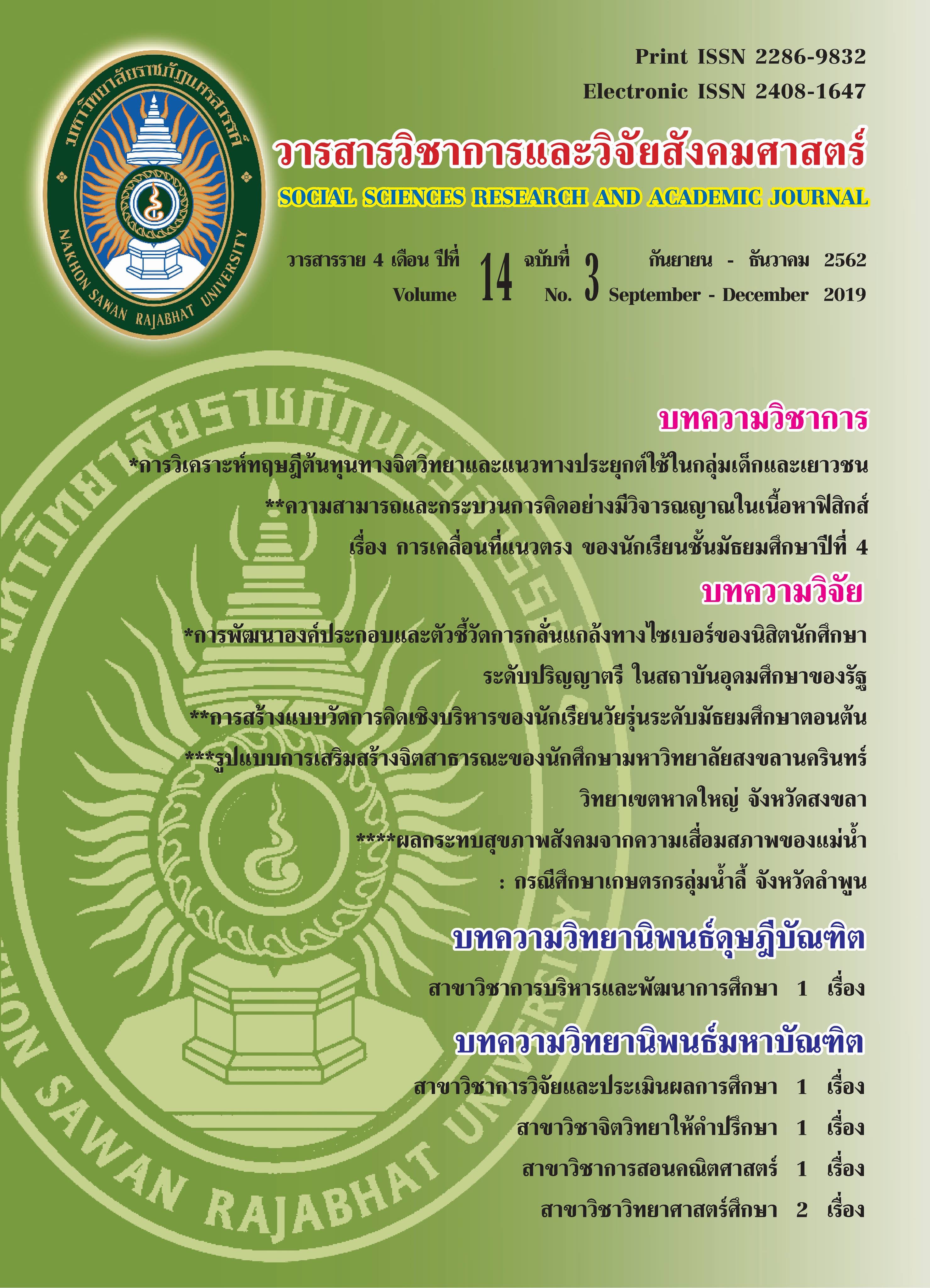การพัฒนาองค์ประกอบและตัวชี้วัดการกลั่นแกล้งทางไซเบอร์ของนิสิตนักศึกษา ระดับปริญญาตรี ในสถาบันอุดมศึกษาของรัฐ The Development of the Cyber Bullying Factor and Indicators of Undergraduate Students in Higher Education Institutions
Main Article Content
Abstract
การวิจัยครั้งนี้มีวัตถุประสงค์เพื่อ 1) ศึกษาองค์ประกอบและตัวชี้วัดการกลั่นแกล้งทางไซเบอร์ของนิสิตนักศึกษาในสถาบันอุดมศึกษาของรัฐ และ 2) ตรวจสอบความตรงเชิงโครงสร้างขององค์ประกอบและตัวชี้วัดการกลั่นแกล้งทางไซเบอร์ของนิสิตนักศึกษาในสถาบันอุดมศึกษาของรัฐ กลุ่มตัวอย่างเป็นนิสิตนักศึกษาในสถาบันอุดมศึกษาของรัฐ รวมทั้งสิ้น 2,200 คน ที่ได้มาจากการสุ่มแบบหลายขั้นตอน (Multi-stage Random Sampling) เครื่องมือที่ใช้ในการวิจัยเป็นแบบสอบถาม มีลักษณะเป็นมาตรประมาณค่า (Rating Scale) 5 ระดับ สถิติที่ใช้ในการวิเคราะห์ข้อมูล ได้แก่ การวิเคราะห์องค์ประกอบเชิงสำรวจ (Exploratory Factor Analysis) และการวิเคราะห์องค์ประกอบเชิงยืนยันอันดับสอง (Second Order Confirmatory Factor Analysis) วิเคราะห์ข้อมูลด้วยโปรแกรม Mplus
ผลการวิจัยพบว่า
1. องค์ประกอบการกลั่นแกล้งทางไซเบอร์ของนิสิตนักศึกษาในสถาบันอุดมศึกษาของรัฐ มีจำนวน 3 องค์ประกอบ 22 ตัวชี้วัด ได้แก่ องค์ประกอบที่ 1 ปลอมแปลงและเปิดเผยข้อมูลผู้อื่นทางโซเชียลมิเดีย (10 ตัวชี้วัด) องค์ประกอบที่ 2 ด่าทอและข่มขู่ผู้อื่นผ่านระบบเครือข่ายอินเทอร์เน็ต (7 ตัวชี้วัด) และองค์ประกอบที่ 3 กีดกันและลบผู้อื่นออกจากการสนทนาออนไลน์ (5 ตัวชี้วัด)
2. องค์ประกอบ และตัวชี้วัดการกลั่นแกล้งทางไซเบอร์ของนิสิตนักศึกษาในสถาบันอุดมศึกษาของรัฐ มีความสอดคล้องกับข้อมูลเชิงประจักษ์ (Chi-square = 99.639, df = 89, ค่า p-value = 0.2069, RMSEA = 0.011, CFI = 0.999 และ SRMR = 0.016) และมีความตรงเชิงโครงสร้าง โดยที่ค่าน้ำหนักองค์ประกอบมีนัยสำคัญทางสถิติที่ระดับ .01 ทุกตัวชี้วัด
The purpose of this research were to 1) study the cyber bullying factor and indicators of undergraduate students in higher education institutions, and 2) investigate the construct validity of cyber bullying factor and indicators of undergraduate students in higher education institutions. The sample was consisted of 2,200 undergraduate students in higher education institutions with selected from a multi-stage random sampling. The research instruments were a rating scale questionnaire. Statistic for data analysis consisted of exploratory factor analysis and second order confirmatory factor analysis which computed Mplus program.
The result revealed that:
1. the factor of the cyber bullying factor and indicators of undergraduate students in higher education institutions consisted of 3 factors include, counterfeiting and revealing others' personal via social media (10 indicators), abusing and intimidating others via internet (7 indicators), and depriving and deleting other from online chat (3 indicators).
2. the factor and indicators of the cyber bullying factor and indicators of undergraduate students in higher education institutions correlated with empirical data (Chi-square = 99.639, df = 89, ค่า p-value = 0.2069, RMSEA = 0.011, CFI = 0.999 และ SRMR = 0.016) and had construct validity with factor loading have statistical significance at the level of .01 on all indicators
Article Details
References
พิมพวัลย์ บุญมงคล, ณัฐรัชต์ สาเมาะ, Timo T. Ojanen, รณภูมิ สามัคคีคารมย์, และ Thomas E. Guadamuz. (2557). การรับรู้ของเยาวชนต่อการรังแกในพื้นที่ไซเบอร์. วารสารพฤติกรรมศาสตร์เพื่อการพัฒนา, 6(1), 351-363.
ศิวพร ปกป้อง และวิมลทิพย์ มุสิกพันธ์. (2553). ปัจจัยที่มีผลต่อทัศนคติและพฤติกรรมการกระทำความรุนแรงทั้งทางกายและการข่มเหงรังแกผ่านทางโลกไซเบอร์ของเยาวชนไทย. รายงานการวิจัย, มหาวิทยาลัยมหิดล.
สำนักงานสถิติแห่งชาติ, กระทรวงดิจิทัลเพื่อเศรษฐกิจและสังคม. (2561). สรุปผลที่สำคัญ สำรวจการมีการใช้เทคโนโลยีดิจิทัลและการสื่อสารในครัวเรือน พ.ศ. 2560 (ไตรมาส 1). กรุงเทพฯ: กองสถิติพยากรณ์ สำนักงานสถิติแห่งชาติ.
Bhat, S. C. (2008). Cyber Bullying: Overview and Strategies for School Counsellors, Guidance Officers, and All School Personnel. Australian Journal of Guidance and Counselling, 18(1), 53-66.
Conway, A. (2009). The internet generation: Bullying has gone digital the impact of cyberbullying on adolescent identity. Master’s thesis, Ireland: University of Dublin.
Cook, S. W., & Heppner, P. P. (1997). A psychometric study of three coping measures. Educational and Psychological Measurement, 57(6), 506-523.
David, C. & Hertz, M.F. (2007). Electronic Media, violence, and adolescents: An emerging public health problem. Journal of Adolescent Health, 41(6), 1-5.
Donner, J. (2010). Research approaches to mobile use in the developing world: A review of the literature. Journal of Information Society, 24(3), 140-159.
Folkman, R. S., & Lazarus, S. (1984). Stress appraisal and coping. New York: Springer Publishing Company.
Huang, Y. Y., & Chou, C. (2010). An analysis of multiple factors of cyberbullying among junior high school students in Taiwan. Journal of Computers in Human Behavior, 26(6), 1581-1590.
Hins, N. H. (2011). Traditional bullying and cyber-bullying: are the impacts on self-concept the same. Doctor of Education, Western Carolina University.
Kowalski, R. M., Limber, Susan P., & A gatston, Patricia W. (2008). Cyber bullying: bullying in the digital age. Massachusetts: Blackwell.
Mishna, F., Saini, M., & Solomon, S. (2009). Ongoing and online: Children and youth’s perceptions of cyberbullying. Children and Youth Services Review, 31(12), 1222-1228.
Nansel, T.R., Overpeck, M., Pilla, R.S., Ruan, W.J., Simons-Morton, B. & Scheidt, P. (2001). Bullying behaviors among US youth: Prevalence and association with psychosocial adjustment. Journal of the American Medical Association, 285(16), 2094-2100.
Shariff, S. (2008). Cyber-Bullying: Issues and solutions for the school, the classroom and the home. Oxon, United Kingdom: Routledge.
Turnage, A. (2007). Email flaming Behaviors and organizational conflict. Journal of Computer Mediated Communication, 13(1), 43-59.
Williams, K. D. (2001). Ostracism: the power of silence. New York: Guilford Press.

